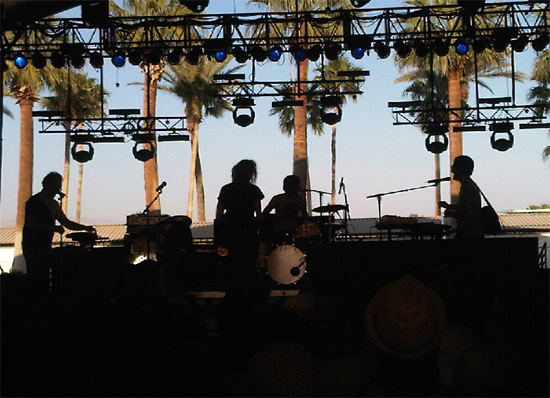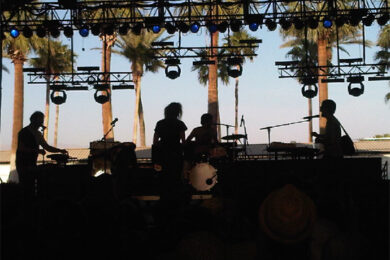In Indio in the Californian desert, I am jetlagged to the point of hallucination, freaked out by the shiny, happy hedge-fund hippies that surround me at the 2011 Coachella Festival. Musclemen and Daisy Dukes, who appear to me right now like body-fascistic proponents of the kind of psychotic power games dreamed up by Burroughs or Hunter S, so at home do they seem here in the green, palm-lined grounds of this exclusive polo club in the otherwise dusty Coachella Valley where the festival takes place each year.
As often is the case in America, though, I find it hard to fully see what is in front of me: jetlag depletes the senses and I wander around allowing sights and sounds to awaken memories formed from days and days of watching trashy TV, children’s comedies and low-grade Hollywood movies during the holidays in the 90s, which all seemed to emanate, stylistically at least, from America’s entertainment heart, the Golden State. Ciro, the kid receptionist at the shabby hotel that we stayed at near LAX airport the night before, had a bowl-and-sideburns haircut that I swear I had seen in an episode of Quantum Leap some years earlier; his not-quite-broken, squeaky speech took me back to a Simpsons episode I’d last seen 13 years ago. As a 1970s MOR station blared in the air conditioned hire car on the way to Indio next morning, all the Californian clichés had grabbed hold of me: the freeways that swooped through the sky like rare, focussed dreams on the way out of LA; the unending blue sky and heat, and the palm after palm after palm that flew by.
Last year I wrote a slightly ranty article for this site (file it under “Sure It’s Skewed But Didn’t It Get You Talking!”) that bemoaned the export of recycled lo-fi sensibilities emanating out of California that had resulted in hypnagogic pop, glo-fi and the like seizing the global indie zeitgeist without breathing much life into it. I singled out the scene’s apparent figurehead: “Ariel Pink enjoys a comparable position to the Velvet Underground in that he is, above all others, seen as the linchpin behind this disparate bedroom scene, but between the two there is a chasm in sentiment and quality. The Velvets used irony sparingly, as counterpoints to offset thrilling dirge, wild, cataclysmic noise and beauty. With Pink, it is laden so thick that these ears have trouble distinguishing it from parody.”
Sometimes, though, you have to go to the source to fully understand something and, wiping chips off my shoulders as if they were blocks of dandruff, I wandered dazed yet purposefully into the tent for Ariel Pink’s Haunted Graffiti. Star and band stood against the bolt-upright palms and mandatory blue sky behind the stage like dark-yet-hilarious suppressed thoughts that had suddenly manifested themselves into shapes and sounds. Songs that seemed at first to struggle to assert themselves wriggled into your head; a bit like Beefheart-style jamming with 1970s and 80s rock and pop as its starting point and not the blues. Without noticing I’d found my way to the front. It was mesmerising – music that I’d neglected to give a chance through not opening up to it had bitten me. Elements of belligerence, of refusal, in a festival so commercial it felt like it was taking place in an iPad. I swear I was tearful.
Coming out of my trance, I realised that the vibe around the tent was not quite as chill as I suddenly was. California had made Pink and now you felt, while not rejecting him, it was doing even worse: it was meh-ing him. Irritable indifference was the feeling that hung around us, enmeshed with the fragrant hint of weed (which I thought might be the sole vice of these latte-sipping festival-goers until later at Magnetic Man, when I saw a topless and gurning giant of a man stare into the end of his own wiggling fingers: he was lost in his makeshift glow-gloves, the more he wiggled his pinkies, the more beautiful secrets he would receive from some distant, unspeakable source).
“I know you hate me,” Pink, sensitive to crowd’s antipathy, spat at them with a chew-wasp face. “We’re not gonna play anymore. I’m sorry.” He fled behind the stage, ran around, jumping up and down with his fists clenched; he smoked his cigarette so hard he nearly ate it. He came back, though, fizzing and wild with an aggression that shook his diminutive frame, a rare danger in this respectful indie-rock setting (but perhaps only to himself and his band).
He barely sang for the rest of the set, just held strained positions, joining in occasionally, and scowling at band members, stuck between affecting that he did not care in the face of the questioning eyes and ears in the audience, and the reality that he does care: he obviously cares about these songs and his woozy, reverb heavy approach which stem from an almost pathological artistic desire to keep on creating. He couldn’t hide it, the same way the some members of the crowd couldn’t hide the fact that they could take or leave him.
Retromania, published by Faber in June, sees inky legend and Pink-fan Simon Reynolds (a recent émigré to LA from New York) question his faith in his hero and hauntological music in general, in terms of advancing music: “what exactly is this music’s contribution,” he posits. “Isn’t it sterile?” But is there any other choice within the enforced conditions of the internet, which in giving us everything at once has resulted in making us feel as if nothing will ever happen again? That’s the topic of discussion in the writer’s latest essay for the new issue of Wire, which acts as an accompaniment to Retromania. It problematises the current malaise, looking at its main cause, the rise of digital culture. “Fanatical identification with an artist, scene or youth tribe has given way to drifting eclecticism and ‘partial allegiance’,” says Reynolds.
As Haunted Graffiti stopped playing for the final time in a stunted yet thrilling performance, there were vague shouts of “Arsehole” and similar from those around me that had stayed until the end, while Pink scrambled around the stage floor to collect up his things. But as the crowd thinned, some rushed to the front, with one or two arms stretched out: perhaps grasping to touch this mirage of a superstar, a miniature hero alive and unwell in front of their eyes. This bedraggled person behind the name that has twinkled on thousands of computer screens around the world: is that what a star looks like?
Ariel Pink’s Haunted Graffiti play Koko tonight before a small UK tour. They play The Quietus Village Mentality Stage at Field Day on August 6th



